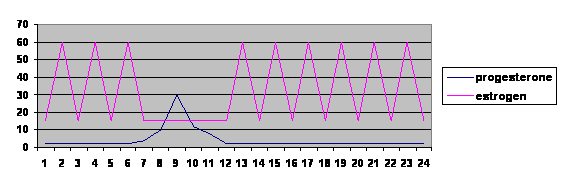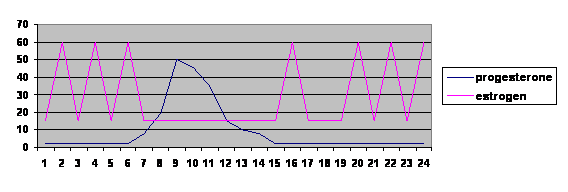What is estrogen?
Estrogen is a steroid hormone produced mainly from the ovaries, but can also be produced from the adrenal glands and placenta (tissue that communicates between baby and mom during pregnancy).
When is estrogen produced?
Estrogen is produced in significant amounts during the follicular phase (growth and development of eggs from the queen's ovaries) of her estrus (heat). It goes back to baseline at either the diestrus, anestrus or interestrus phases. Estrus can typically last from 2-19 days, separated by an interestrus of 8-10 days.
Sterile mating took place at week 6. False pregnancy ended 42 days later.

Fertile mating took place at week 6, followed by diestrus of 65 days. Lactation would inhibit estrogen peaks for another month.

Duration until the queen is mated and induced to ovulate or (a more uncommon) spontaneous ovulation takes place. She may also exit estrus as a result of decreasing daylength as the queen is a seasonal breeder like the horse. Unlike the dog, some smaller but potentially significant amounts of estrogen can be released during a pregnancy accounting for signs of heat despite her pregnant condition. It is though by some scientists, that this may also account for some cases of spontaneous abortions mid-to late gestation in queens. Estrogen may also come from disease conditions of the ovaries such as ovarian cysts and from estrogen secreting tumors (e.g. granulosa cell tumor and androblastoma of the ovary ). There is no practical application for estrogen to be given as a medication in the queen, but external sources inadvertently given by owners that may be on hormone replacement therapy (transdermal creams/gels) or accidental ingestion of certain forms of birth control can infrequently occur.
What does estrogen do?
Estrogen has many roles:
1: It is involved in the growth, maturation and release of oocytes (eggs) from the queen's ovaries.
2: It prepares the lower reproductive tract for breeding, by thickening and lubricating the lining of the vagina. It promotes growth, increased blood supply, fluid accumulation in the endometrium of the uterus and supports migration of white blood cells into the uterine lumen to help defend it from invading pathogens.
3: It assists with motility and transport of male and female gametes (eggs and sperm) towards each other and transport of the embryo toward the uterus at the correct time.
4: It assists with preparation of the reproductive tract for delivery of the fully developed fetus (lubricates the vagina and softens the cervix) and aids in other hormones' effects to cause muscular contractions of the uterus.
5: It is involved in growth and development of the mammary tissue through puberty.
6: It affects the queen's behavior, to make her both more attractive and receptive to tom cats.
What are the clinical signs of elevated estrogen?
The signs of increased estrogen that most of us are familiar with include: increased vocalization, head rubbing and solicitation of physical affection from owners, other animals, objects. The queen in estrus will assume a crouched posture with her chest close to the floor and back hyperextended with or without treading of her hindfeet. She may also hold her tail off to one side presenting her vulva to the male. It is during this time, most intact female cats are likely to get of the owner's house. Queens typically roam to the territory of an intact male. This behavior may occur in a cyclic pattern, separated by as few as 1-2 days or as long as 7-10 days until the female is either mated or simply goes out of season due to decreasing daylight hours. In some Oriental breeds, the interestrous period can be so brief (a few hours) as too appear as though the queen is continuously in heat. This condition needs to be differentiated from other pathologic conditions e.g. ovarian cysts or tumors that can persistently secrete estradiol.
How do you test for estrogen levels?
Normally, outward clinical signs (as mentioned above) are already supportive of increased estrogen. Vaginal cytology can be used to detect the effects of estrogen on the queen's vaginal tract. However, sustained or frequent vaginal stimulation may result in ovulation. This may or may not be desired at the time of testing. A swab of the queen's vagina yields more flattened cells with no nuclei, at the height of estrus. These are referred to as cornified epithelial cells and resemble "corn flakes" when viewed under the microscope. Here are some examples of cells seen on vaginal cytology (from LSU therio website)

No information about the exact quantity of estrogen in the bloodstream is derived from this testing. It is rather, a retrospective look at the cumulative effects of estrogen.
Why can't you do a blood test for estrogen levels?
Well, you can sample serum for hormone levels, and estrogen rises and peaks over several days, but these assays can be expensive and are usually reserved for diagnosis in cases of abnormal reproductive cycles.
My cat has been spayed, but is showing clinical signs consistent with elevated estrogen. How is this possible?
Most likely, the cat is exposed to another form of estrogen from external sources. Hormone replacement therapy in menopausal women is often prescribed as transdermal creams or gels. It is very easy to a pet to become exposed to these hormones if they are applied to an area of the body that the cat may have contact with afterward e.g. inside of a leg or arm. Ingestion of certain forms of birth control or other estrogenic substances can be a cause as well. In rare cases, estrogen may come from the pet's food or water supply (usually more than one animal in household involved or new batch of food).
In some cases, a little piece of ovary may be left behind post-spay surgery. This is referred to as ovarian remnant syndrome. The queen still demonstrates estrus although cannot become pregnant if the uterus was removed.
There are tests that can be performed to diagnose ovarian remnant syndrome prior to surgical exploration (LH assay, progesterone tests and abdominal ultrasound). Surgical exploration of confirmed cases and removal of the retained ovarian tissue is advised in all cases as the remnant is at increased risk for neoplasia.
Our Pet Health Mission
Our mission at Newport Harbor Animal Hospital is: "To provide the highest quality veterinary care for our patients and the best service for our clients. Our goal in every case is a healthy pet and a happy client."
